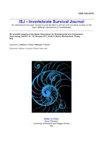Combined effects of surface waters and CeO nanoparticle in zebra mussels
IF 1.2
4区 农林科学
Q4 IMMUNOLOGY
引用次数: 1
Abstract
Cerium oxide nanoparticles (nCeO) are currently used in many sectors of our economy, for instance as fuel additives and in ceramics for catalytic converters. As a result, there are concerns about their release and resulting toxicity in the aquatic environment. The purpose of this study was to examine the bioavailability and toxicity of nCeO and Ce(IV) in zebra mussels (Dreissena polymorpha) in various types of surface water differing in organic matter, conductivity and pH. Mussels were exposed to 100 μg/L Ce as either nCeO or Ce(IV) for 96 h in 4 types of water: 1) green water (high conductivity and low total organic carbon), 2) brown water (low conductivity and high natural total organic matter), 3) 10% municipal effluent (high conductivity and high anthropogenic organic matter) and 4) controls, which consisted of dechlorinated tap water. After the exposure period, the mussels were analyzed for morphological changes, resistance to survive in air, triglycerides (fat reserves), oxidative stress (arachidonate cyclooxygenase and lipid peroxidation) and DNA damage. Evidence of aggregation was observed with nCeO in most types of water, with the exception of the diluted municipal effluent. The data revealed that some of the effects of nCeO were influenced by surface water properties. The mussels were more sensitive to air emersion when exposed to nCeO in green water but not in the other water types and Ce(IV) to all types of water, although a marginal decrease was observed in mussels co-exposed to the diluted municipal effluent. A general decrease in oxidative stress and lipid levels was observed with both forms of Ce and all water types. Ce(IV) in brown water did not reduce the levels of DNA strand breaks compared with the controls. In conclusion, the sublethal toxicity of nCeO could be modulated by the surface water from which the nanoparticle is suspended.地表水与CeO纳米颗粒对斑马贻贝的联合作用
氧化铈纳米颗粒(nCeO)目前应用于我国经济的许多部门,例如用作燃料添加剂和用于催化转化器的陶瓷。因此,人们担心它们的释放及其在水生环境中的毒性。本研究的目的是研究不同有机质、电导率和ph的地表水中nCeO和Ce(IV)在斑马贻贝(Dreissena polymorpha)体内的生物利用度和毒性。将100 μg/L的nCeO或Ce(IV)暴露于4种不同类型的水中96 h:1)绿水(高导电性和低总有机碳),2)棕色水(低导电性和高天然总有机质),3)10%的城市污水(高导电性和高人为有机质)和4)由脱氯自来水组成的对照。暴露后,分析贻贝的形态变化、在空气中生存的抵抗力、甘油三酯(脂肪储备)、氧化应激(花生四烯酸环加氧酶和脂质过氧化)和DNA损伤。除了稀释的城市污水外,在大多数类型的水中都观察到nCeO聚集的证据。数据显示,nCeO的某些作用受地表水性质的影响。贻贝在绿水中暴露于nCeO时对空气浸润更敏感,而在其他类型的水中则不敏感,而在所有类型的水中暴露于Ce(IV),尽管在共同暴露于稀释的城市污水中观察到贻贝的边际下降。两种形式的Ce和所有水类型均观察到氧化应激和脂质水平普遍下降。与对照组相比,褐色水中的Ce(IV)并没有降低DNA链断裂的水平。综上所述,纳米颗粒悬浮的地表水可以调节nCeO的亚致死毒性。
本文章由计算机程序翻译,如有差异,请以英文原文为准。
求助全文
约1分钟内获得全文
求助全文
来源期刊

ISJ-Invertebrate Survival Journal
IMMUNOLOGY-ZOOLOGY
CiteScore
2.10
自引率
0.00%
发文量
0
审稿时长
>12 weeks
期刊介绍:
Invertebrate Survival Journal (ISJ) is an international and open access journal devoted to prompt and innovative studies on the basic defense mechanisms in invertebrates, in particular with a view to identifying biotechnologies able to act against derived diseases and related economic damage.
Contributions will be mainly in the form of Letters to the Editor, Visions and Perspectives, Short Communications, Technical Reports, Research Reports, Review, Minireview and Reports of Meetings. Letters to the Editor can be commentaries or perspectives on invertebrate defence mechanisms or replies to the data published in ISJ.
 求助内容:
求助内容: 应助结果提醒方式:
应助结果提醒方式:


